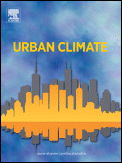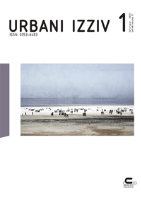
Teka Komisji Urbanistyki i Architektury
Scope & Guideline
Exploring the Intersection of Architecture and Urbanism.
Introduction
Aims and Scopes
- Urban Design and Planning:
The journal explores various aspects of urban design and planning, including spatial organization, land use, and the integration of green spaces within urban environments. - Sustainability and Environmental Impact:
Research emphasizes sustainable architectural practices and urban planning strategies that mitigate environmental impacts, focusing on climate change adaptation and ecological quality. - Cultural Heritage Preservation:
The journal highlights the importance of preserving cultural heritage in urban settings, examining historical architecture and its relevance in contemporary urban development. - Technological Integration in Architecture:
A focus on the use of digital tools and innovative materials in architectural design, exploring how technology can enhance functionality and sustainability in urban contexts. - Social Aspects of Urban Spaces:
The journal addresses the social dynamics within urban spaces, studying the role of public areas, recreational facilities, and community engagement in urban design.
Trending and Emerging
- Smart City Concepts:
An increasing focus on smart city initiatives highlights the integration of technology in urban planning, aiming to enhance the efficiency and livability of urban environments. - Green Infrastructure and Urban Ecology:
There is a growing trend towards studying green infrastructure as a means to improve urban resilience and ecological health, emphasizing the role of parks and natural areas in urban settings. - Public Health and Urban Design:
Research exploring the relationship between urban design and public health is on the rise, reflecting a heightened awareness of how urban environments affect community well-being. - Active Mobility Solutions:
The journal is increasingly addressing themes related to active mobility, such as cycling and pedestrian-friendly infrastructure, as cities seek to promote sustainable transportation options. - Crisis-Responsive Urban Planning:
Emerging discussions around urban planning in response to crises, such as pandemics and climate change, indicate a shift towards adaptive strategies that prioritize resilience and community engagement.
Declining or Waning
- Historical Architectural Styles:
There has been a noticeable decrease in studies focused solely on historical architectural styles and their aesthetic evaluations, possibly due to a shift towards more contemporary and sustainable design practices. - Traditional Urbanism:
Research centered on traditional urbanism and its principles has become less prominent, indicating a potential move away from historical methodologies in favor of modern urban strategies. - Monument Conservation:
The specific focus on monument conservation practices has diminished in favor of broader discussions on cultural heritage, suggesting a transition towards more integrated approaches to urban heritage.
Similar Journals

Techne-Journal of Technology for Architecture and Environment
Innovating Architecture for Tomorrow's ChallengesTechne - Journal of Technology for Architecture and Environment, published by FIRENZE UNIV PRESS, is an important academic platform that bridges the gap between technology and architecture while addressing the evolving environmental challenges of our time. Established in 2015, this journal provides a forum for innovative research and discussions that critically examine the intersections of architecture, urban studies, and construction engineering. With an impact factor indicative of growing recognition in its field, Techne encompasses a broad spectrum of studies, marking its presence in the Q3 and Q4 quartiles across various categories, including Architecture, Building and Construction, Education, and Health (Social Science). The journal is indexed in Scopus with varying ranks, showcasing its increasing relevance and influence among contemporary literature. Although it operates under a non-open access model, the journal ensures that its scholarly contributions are accessible through institutional connections, making it a vital resource for researchers, professionals, and students seeking to advance their knowledge on the integration of technology in shaping sustainable architectural practices.

A + U-ARCHITECTURE AND URBANISM
Exploring the Intersection of Design and Urban LifeA + U - ARCHITECTURE AND URBANISM, published by A & U PUBL CO LTD, is a prominent Japanese journal that focuses on the interdisciplinary nexus of architecture, urban studies, and the visual arts. With an ISSN of 0389-9160, this publication aims to provide a platform for innovative research and discourse in the challenging and ever-evolving landscapes of architecture and urbanism. Despite being placed in Q4 of various categories according to Scopus ranks, this journal holds significance in fostering global dialogues on urban transformations and design strategies through its diverse range of articles. The journal emphasizes not only the aesthetic dimensions of architecture but also the social and cultural implications of urban development, thereby appealing to a broad audience of researchers, professionals, and students dedicated to these fields. With a commitment to enriching the academic community, A + U serves as a vital resource for those seeking to explore and contribute to the future of urban spaces and architectural practices.

Urban Climate
Shaping Sustainable Cities Through Climate InsightsUrban Climate, published by Elsevier, is a leading peer-reviewed journal dedicated to advancing the understanding of interactions between urban areas and climate patterns. Since its inception in 2012, the journal has achieved an impressive reputation, currently holding a Q1 ranking in multiple categories, including Atmospheric Science, Environmental Science, Geography, Planning and Development, and Urban Studies. This positions it as a vital resource for researchers, professionals, and students interested in the multifaceted dynamics of urban environments and their climatic impacts. With an overarching goal to foster interdisciplinary collaboration, Urban Climate serves as a platform for innovative research designed to inform city planning and policy, enhance sustainability, and address climate-related challenges in urban settings. As the only journal solely focused on urban climate issues, it stands out as a crucial contributor to the academic discourse in this field, promoting open discussions and providing accessible insights critical for shaping resilient urban futures.

International Journal of Built Environment and Sustainability
Pioneering Research for Sustainable Development in ArchitectureInternational Journal of Built Environment and Sustainability, published by PENERBIT UTM PRESS, serves as a pivotal platform for the dissemination of research in the fields of architecture, urban planning, and sustainable development. With an E-ISSN of 2289-8948 and having embraced Open Access since 2014, this journal ensures that critical findings in built environment research are accessible to a global audience, fostering innovation and collaboration among researchers, professionals, and students. Although the H-index and specific scope are currently not detailed, the journal's commitment to advancing sustainable practices in the built environment makes it an invaluable resource for those dedicated to tackling the pressing challenges of sustainability in our communities. As part of its mission, the journal prioritizes high-quality, peer-reviewed articles that contribute to both academic theory and practical applications, solidifying its role in shaping the future of our built environments.

Prostor
Empowering Researchers to Transform the Built EnvironmentProstor is an esteemed scholarly journal published by the University of Zagreb, Faculty of Architecture, dedicated to advancing knowledge in the fields of architecture, urban planning, and spatial studies. Since transitioning to an Open Access model in 2006, Prostor has made significant strides in providing unrestricted access to its contents, fostering a vibrant community of researchers, practitioners, and students interested in contemporary issues surrounding the built environment and social space. The journal's commitment to quality is reflected in its impressive rank within Scopus, particularly in the Arts and Humanities category (64th percentile) and within Engineering (Architecture) at the 49th percentile. Covering a broad array of interdisciplinary topics, Prostor serves as a vital platform for disseminating innovative research and fostering dialogue among professionals while engaging with practical and theoretical explorations of spatial design. With coverage spanning over two decades, Prostor remains a crucial resource for anyone seeking to navigate the complexities of architecture and urban studies.

Journal of Architecture and Planning -King Saud University
Navigating the Future of Urban Environments.Journal of Architecture and Planning, published by King Saud University Press, serves as a critical platform for scholarly dialogue and innovation within the field of architecture and urban planning. This peer-reviewed journal, bearing the ISSN 1018-3604, aims to disseminate high-quality research that addresses contemporary challenges in architectural design, environmental sustainability, and urban development. Situated in Riyadh, Saudi Arabia, this journal not only highlights regional architectural practices but also fosters global discussions, making it an essential resource for researchers, professionals, and students alike. Although currently not open access, the journal is dedicated to providing extensive coverage of the latest findings and theoretical advancements in architecture and planning, paving the way for impactful contributions that can transform communities and enhance the built environment.

i2 Investigacion e Innovacion en Arquitectura y Territorio
Exploring innovative pathways in urban planning and environmental design.i2 Investigacion e Innovacion en Arquitectura y Territorio is a leading open-access journal published by the University of Alicante, dedicated to advancing research and innovation in the fields of architecture and territorial development. Since its inception in 2013, this journal has aimed to provide a robust platform for scholarly discourse, promoting interdisciplinary approaches that connect academic insights with practical applications in urban planning and environmental design. With its commitment to accessibility, the journal ensures that cutting-edge findings and case studies are readily available to researchers, professionals, and students alike, fostering collaboration and informed decision-making. As the landscape of architecture and geography continues to evolve, the i2 journal stands out as a crucial resource for enhancing knowledge and cultivating innovative practices in these dynamic fields.

Urban Science
Fostering Inclusive Dialogues on Urban SustainabilityUrban Science, published by MDPI in Switzerland, is a pioneering open access journal that has been serving the academic community since 2017. With a robust focus on understanding urban environments through various interdisciplinary lenses such as Environmental Science, Geography, Planning and Development, and Urban Studies, this journal aims to advance knowledge on the complexities of urban living and the challenges that modern cities face. Recognized for its impact, Urban Science holds prestigious rankings, including Q1 in Urban Studies and Q2 in multiple relevant categories. Its presence in leading databases like Scopus, where it stands among the top percentile ranks, underscores its contribution to critical dialogues in urban research. The journal’s commitment to accessibility, targeted toward researchers, professionals, and students alike, fosters an inclusive platform for disseminating innovative ideas and solutions necessary for sustainable urban development.

Urbani Izziv-Urban Challenge
Innovating Solutions for Sustainable CitiesUrbani Izziv - Urban Challenge, a prominent journal in the field of urban studies and planning, is published by the Urban Planning Institute of the Republic of Slovenia. Established in 1993, this Open Access journal aims to foster the dissemination of cutting-edge research and innovative ideas in architecture, cultural studies, and urban development. With an impressive impact, it holds a Q2 ranking in both Architecture and Cultural Studies, while maintaining a solid presence in Geography, Planning and Development, and Urban Studies categories. As of 2023, it ranks within the top 25% of journals in the Cultural Studies discipline, highlighting its pivotal role in shaping urban discourse. Researchers and practitioners alike will find the journal an invaluable resource for exploring the intertwined challenges of urbanization, cultural evolution, and sustainable development. With an expansive convergence from 1994 to 2024, it continues to attract influential contributions that illuminate the dynamics of urban life in Slovenia and beyond.

ICONARP International Journal of Architecture and Planning
Fostering global collaboration in architectural scholarship.ICONARP International Journal of Architecture and Planning is an esteemed open-access publication that serves as a pivotal platform for fostering innovative research and discussions in the fields of architecture and urban design. Published by KONYA TECHNICAL UNIVERSITY, FACULTY OF ARCHITECTURE & DESIGN, this journal has been committed to the dissemination of high-quality academic work since 2013, promoting accessibility and global collaboration among researchers, professionals, and students. With its rigorous peer-review process and a focus on contemporary architectural and planning challenges, ICONARP seeks to contribute significantly to scholarly discourse and practical applications within the built environment. The journal is indexed in various scientific databases, enhancing its visibility and impact in the academic community. By appealing to a diverse audience, ICONARP encourages interdisciplinary studies and innovative solutions that address the complexities of modern architecture and urban living.